There is such diversity in houseplants that, no matter your style, you can always curate an indoor plant collection to perfectly suit you and your home. To this end, some houseplant keepers choose plants with pretty and feminine flowers, while others love stately palms and ferns’ classic lines. But if you love bright colors and striking leaves, why not collect houseplants with patterned foliage?
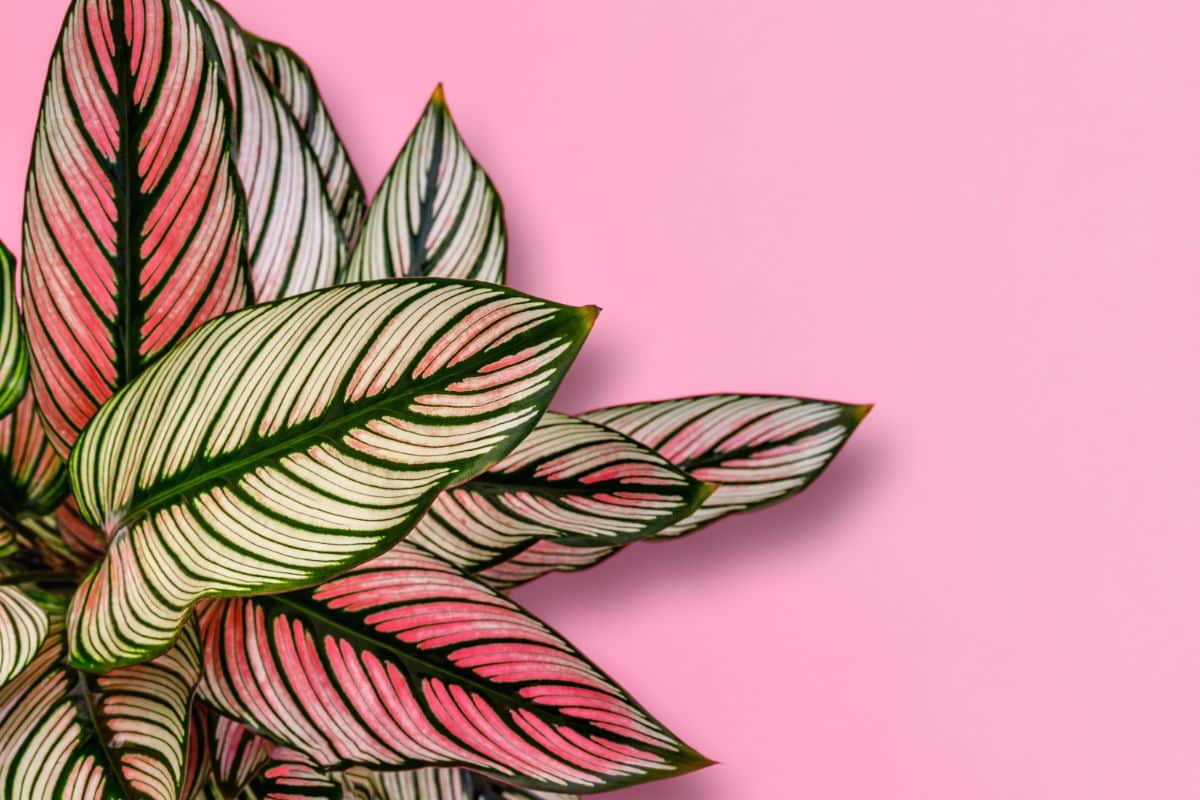
Some houseplants like polka dot begonias are known for their spotted leaves, while some variegated plants can have splashes or patches of white or even completely white leaves! But for a truly impressive display, it’s hard to beat houseplants with big and boldly striped foliage.
You may not think of it, but there are actually quite a few indoor plants that are known for their striated leaf patterns. We’ll explore some of those plants today and hopefully inspire you to pick up a new houseplant or two!
Jump to:
- 20 stunning houseplants with striped leaves
- 1. Spider plant (Chlorophytum comosum)
- 2. Snake plant (Dracaena trifasciata)
- 3. Inch Plant (Tradescantia zebrina)
- 4. Oyster plant (Tradescantia spathacea)
- 5. Bromeliads (Bromeliaceae spp.)
- 6. ‘White jewel’ dracaena (Dracaena deremensis)
- 7. ‘White fusion’ calathea (Calathea lietzei)
- 8. Pleomele (Dracaena reflexa)
- 9. Ti plant (Cordyline fruticosa)
- 10. Haworthia (Haworthia spp.)
- 11. Prayer plant (Maranta leuconeura)
- 12. Variegated banana (Musa × paradisiaca 'Ae Ae')
- 13. Zebra plant (Aphelandra squarrosa)
- 14. Croton (Codiaeum variegatum)
- 15. Birkin philodendron (Philodendron Birkin)
- 16. Variegated cast iron plant (Aspidistra elatior 'Variegata')
- 17. African mask (Alocasia x amazonica 'Polly’)
- 18. Round leaf calathea (Calathea orbifolia)
- 19. Pinstripe calathea (Calathea ornata)
- 20. Nerve plant (Fittonia albivenis)
- Frequently asked questions
- Summary
20 stunning houseplants with striped leaves
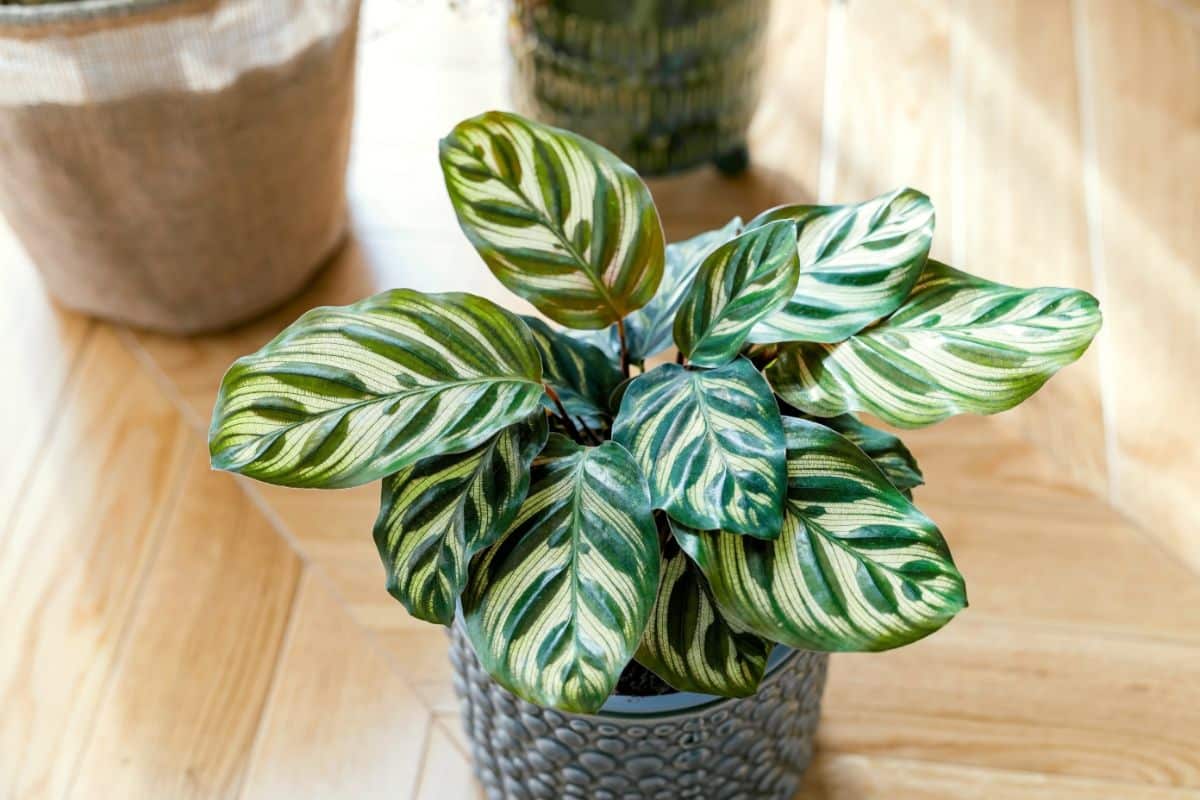
From the ever-popular spider plant to the less commonly collected Pleomele and Ti plants, there are plenty of striped plants to choose from. Below are some of our favorite species, as well as some care suggestions to ensure your new striped plants look their best!
1. Spider plant (Chlorophytum comosum)
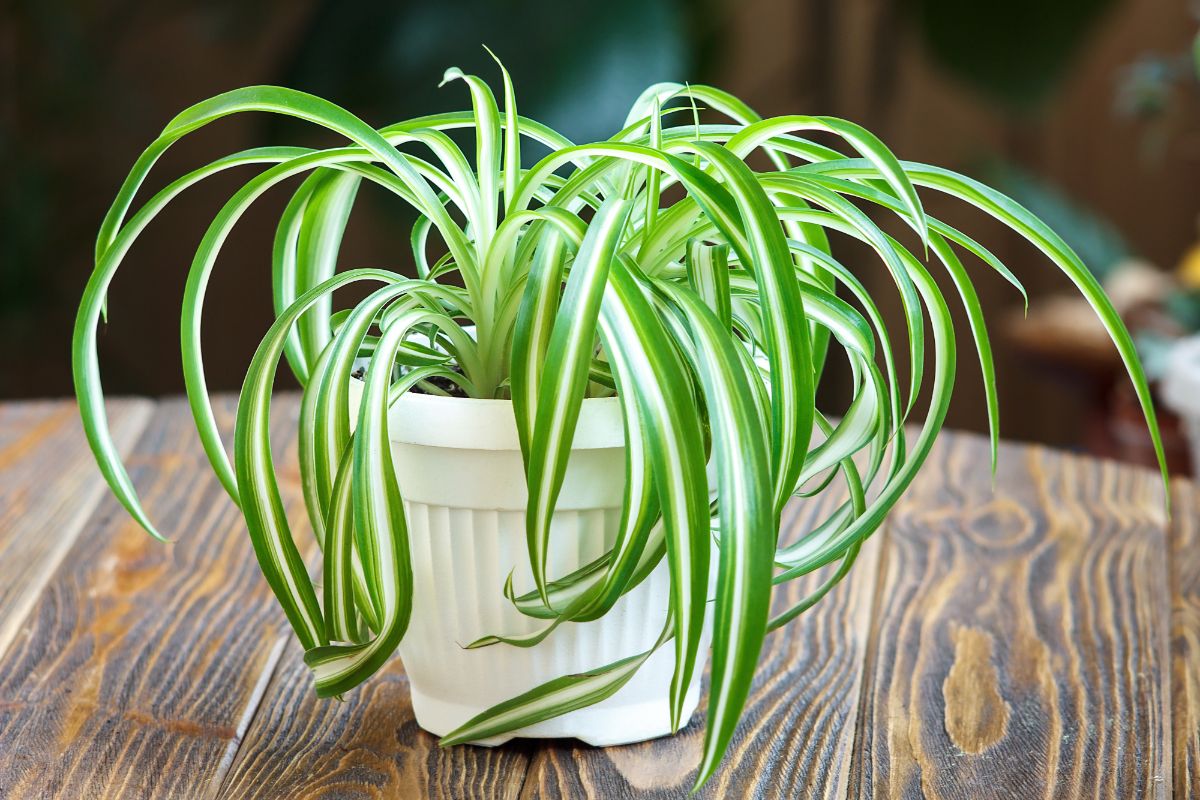
| Plant name: | Spider plant |
| Lighting requirements: | Bright, indirect light |
| Watering requirements: | Moderate |
| Safe for pets? | Yes |
While spider plants come in solid green, they are also available in variegated coloring. These attractive, variegated specimens feature highly contrasting white and green leaves that are slender and grass-like and taper toward the ends. An easygoing plant, spider plants are one of the most popular choices for beginning houseplant keepers since they have such basic care requirements.
Thriving in bright, indirect light, spider plants should be watered regularly so that the soil is moist but never soggy. To determine if it’s time to water your plant, gently insert your finger into the soil. If the top 1 to 2” of soil feels dry, it’s time to bring out your watering can!
2. Snake plant (Dracaena trifasciata)

| Plant name: | Snake plant |
| Lighting requirements: | Bright, indirect light to low light |
| Watering requirements: | Low |
| Safe for pets? | No |
Another classic pick, snake plants are almost infamous for their near indestructibility. These plants require very little water and can even tolerate lower light areas. That said, for happy plants, try to locate your snake plant in an area of your home that receives at least some dappled light.
Snake plants, also sometimes called “mother in law tongues” for their spiky shapes, are actually succulents. As such, they can be susceptible to overwatering, so allow your plant to dry out thoroughly between waterings. If your plant is well maintained, snake plants may even occasionally flower small, white blooms.
3. Inch Plant (Tradescantia zebrina)
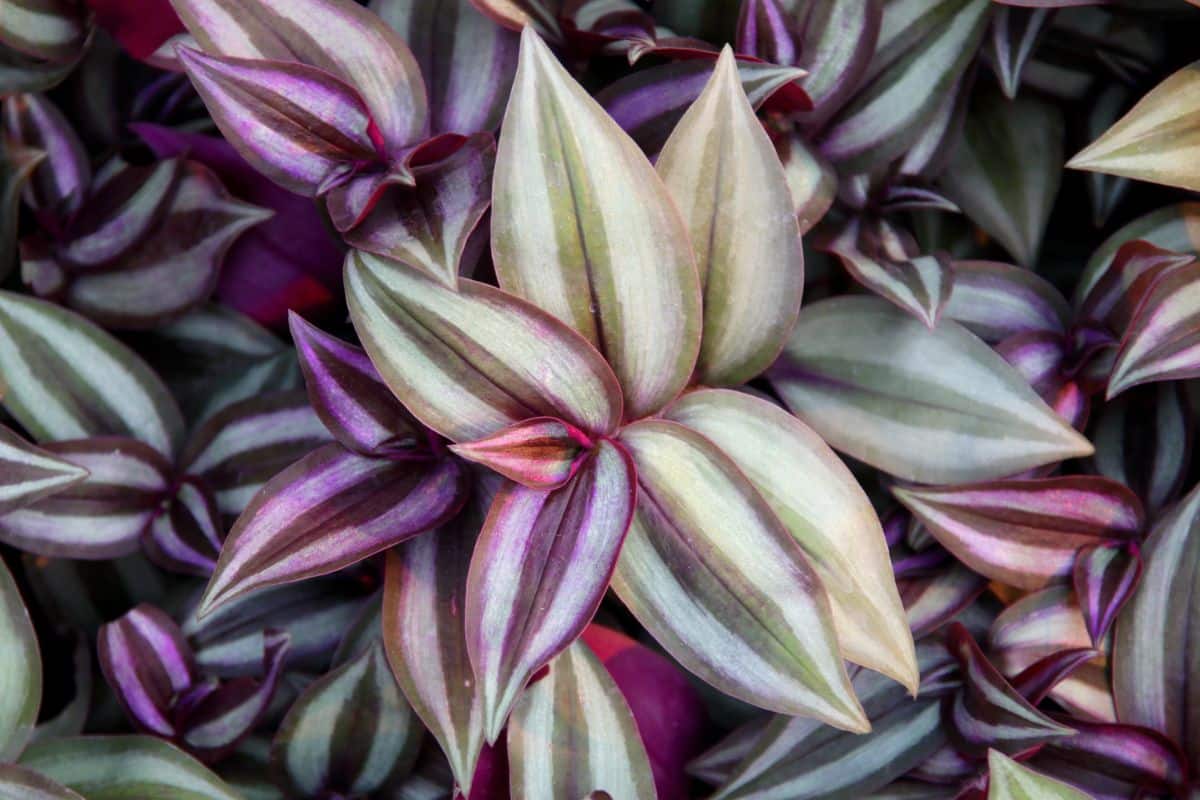
| Plant name: | Inch plant |
| Lighting requirements: | Bright, indirect light |
| Watering requirements: | Moderate |
| Safe for pets? | No |
Inch plants are gorgeous, striped houseplants that come in green or purple. Both varieties have silver striping on their leaves for even more visual interest. Purple-toned inch plants can turn greener in inadequate lighting, so be sure to provide your plants with plenty of bright, indirect light.
Inch plants are semi-succulent species and have thick and fleshy stems, which can be rather delicate. Because their stems can break so easily, many houseplant keepers choose to pot up these plants in hanging baskets where their trailing stems will be more protected. The good news is that if a stem breaks, it can be easily rooted in water to create more plants!
4. Oyster plant (Tradescantia spathacea)

| Plant name: | Oyster plant |
| Lighting requirements: | Bright, indirect light |
| Watering requirements: | Moderate |
| Safe for pets? | No |
A close relative of the inch plant, oyster plants are another fabulously stripey houseplant that is a hit with plant parents! These plants are often kept as low-maintenance groundcovers in more temperate climates, but they make excellent houseplants too.
Easy-care oyster plants can benefit from a bit of extra sun, which will bring out the purple and green striping on the plants’ leaves. Like inch plants, oyster plants can tend to trail and drape out of their pots. So, if you prefer a tidier look, you may want to consider pruning these plants from time to time.
5. Bromeliads (Bromeliaceae spp.)

| Plant name: | Bromeliads |
| Lighting requirements: | Bright, indirect light |
| Watering requirements: | Moderate |
| Safe for pets? | Yes |
Not all bromeliads have striped leaves, but some cultivars have eye-catching, variegated leaves in shades of green, yellow, white, and even pink. Striations on bromeliad leaves can run both horizontally and vertically, so if you love keeping bromeliads, pick up a few different types. Potting up different bromeliads together can make for a truly showstopping houseplant display!
Bromeliads are monocarpic plants, which means they only bloom once in their lifetime before dying back. Choosing to keep bromeliads for their ornamental foliage and their flowers is an easy way to extend the life expectancy of these lovely tropical plants.
Interestingly, pineapples are members of the bromeliad family and can be grown indoors too.
6. ‘White jewel’ dracaena (Dracaena deremensis)
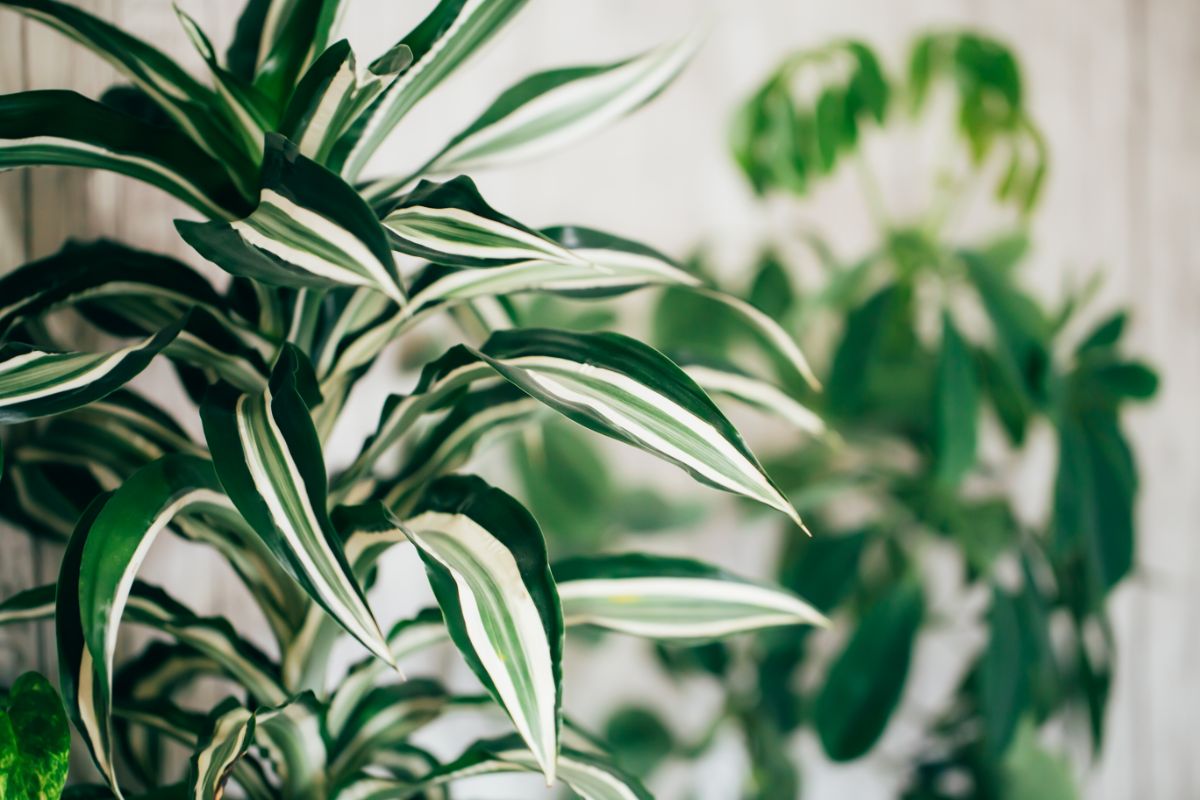
| Plant name: | ‘White jewel’ dracaena |
| Lighting requirements: | Bright, indirect light to low light |
| Watering requirements: | Moderate |
| Safe for pets? | No |
‘White jewel’ dracaena have bright white stripes on dark green, tapering leaves. This highly contrasting patterning really makes this houseplant species stand out in a collection. It’s also why this is one of the most popular plants to keep if you love striped leaves!
Native to Africa, ‘White Jewel’ is often sold as a tabletop plant; however, it can grow to over 10’ tall indoors. This easygoing plant can adapt to moderate to low light levels and is a fine pick if you want an exotic-looking plant without much fuss.
If you like ‘White Jewel,’ closely related corn plants (Dracaena fragrans) also have striped leaves!
7. ‘White fusion’ calathea (Calathea lietzei)
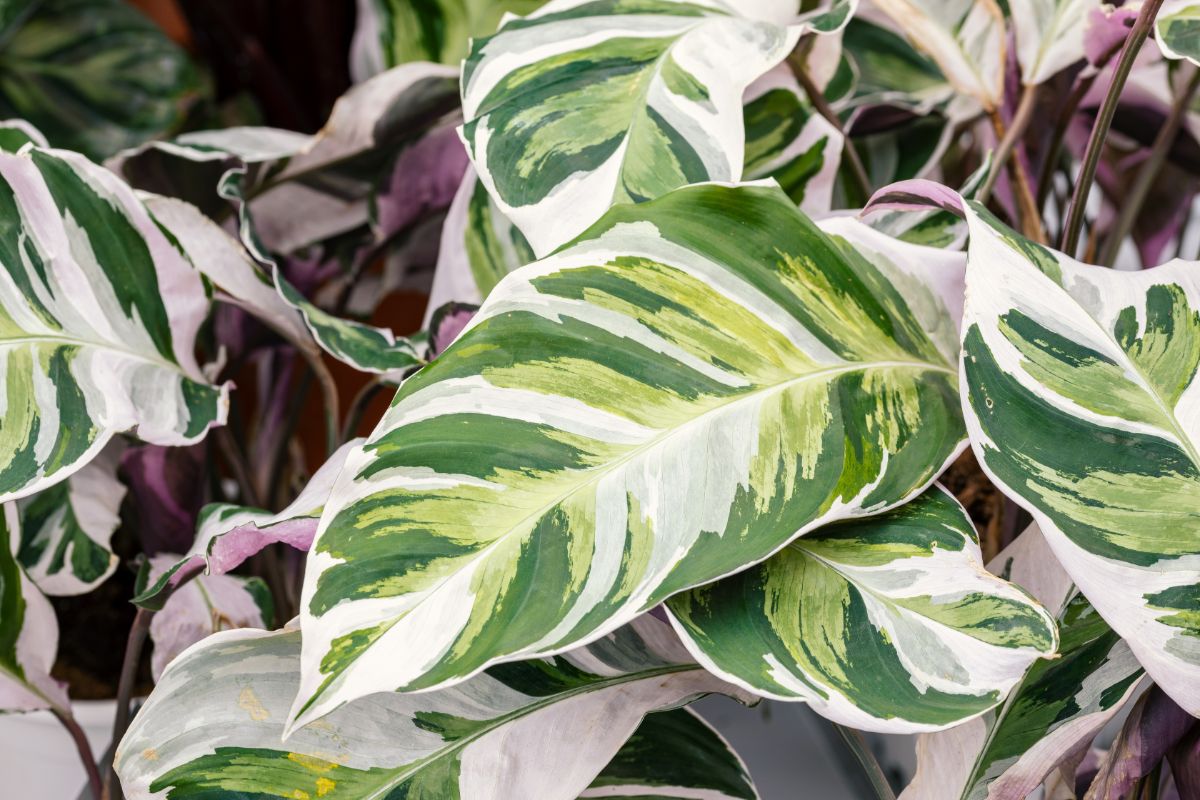
| Plant name: | ‘White fusion’ calathea |
| Lighting requirements: | Bright, indirect light to low light |
| Watering requirements: | Moderate |
| Safe for pets? | Yes |
Calatheas are known for their colorful and patterned leaves, and ‘White Fusion’ is no exception. These attractive plants have boldly patterned leaves in white and green. Leaves have slightly ruffled margins and a magenta-toned underside for an even more “wow” factor.
While ‘White Fusion’ can be a bit pickier than some of the other houseplants on this list, it still makes a wonderful addition to any home’s décor. Just be sure to provide this plant with a bit of extra humidity – at least 50% or higher. Locating your plant on top of a pebble tray or near a humidifier can help as well.
8. Pleomele (Dracaena reflexa)
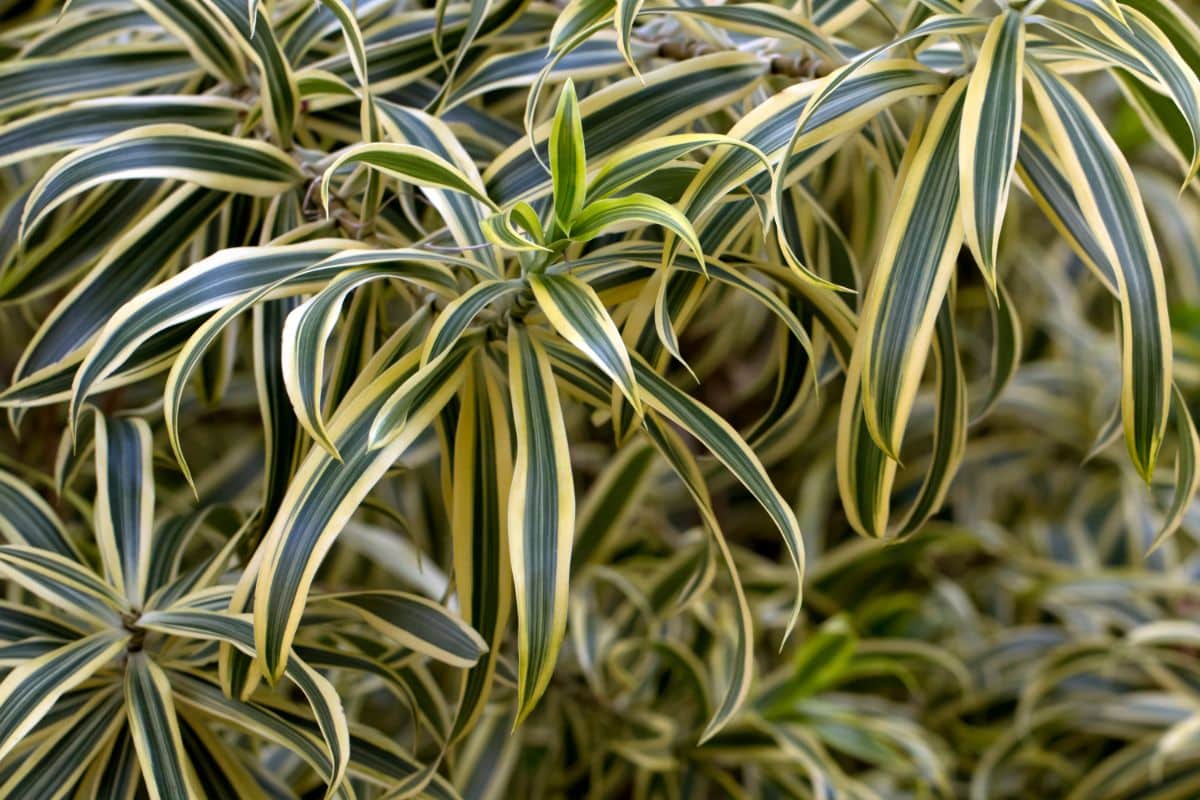
| Plant name: | Pleomele |
| Lighting requirements: | Bright, indirect light |
| Watering requirements: | Moderate |
| Safe for pets? | No |
First described in the literature in 1786, Pleomele is a classic houseplant that is related to the ‘White Jewel’ dracaena. These pretty plants have whorls of leaves that are striped in shades of green and yellow. Native to Madagascar and the surrounding areas, there are actually several different types of Pleomele, and each has slightly different leaf patterning and colors.
Like ‘White Jewel’, this plant is often sold as a tabletop plant, but it can grow up to 19’ high. That said, indoor specimens often stay much smaller and may benefit from the addition of a moss pole or other support if they start to lean over.
9. Ti plant (Cordyline fruticosa)
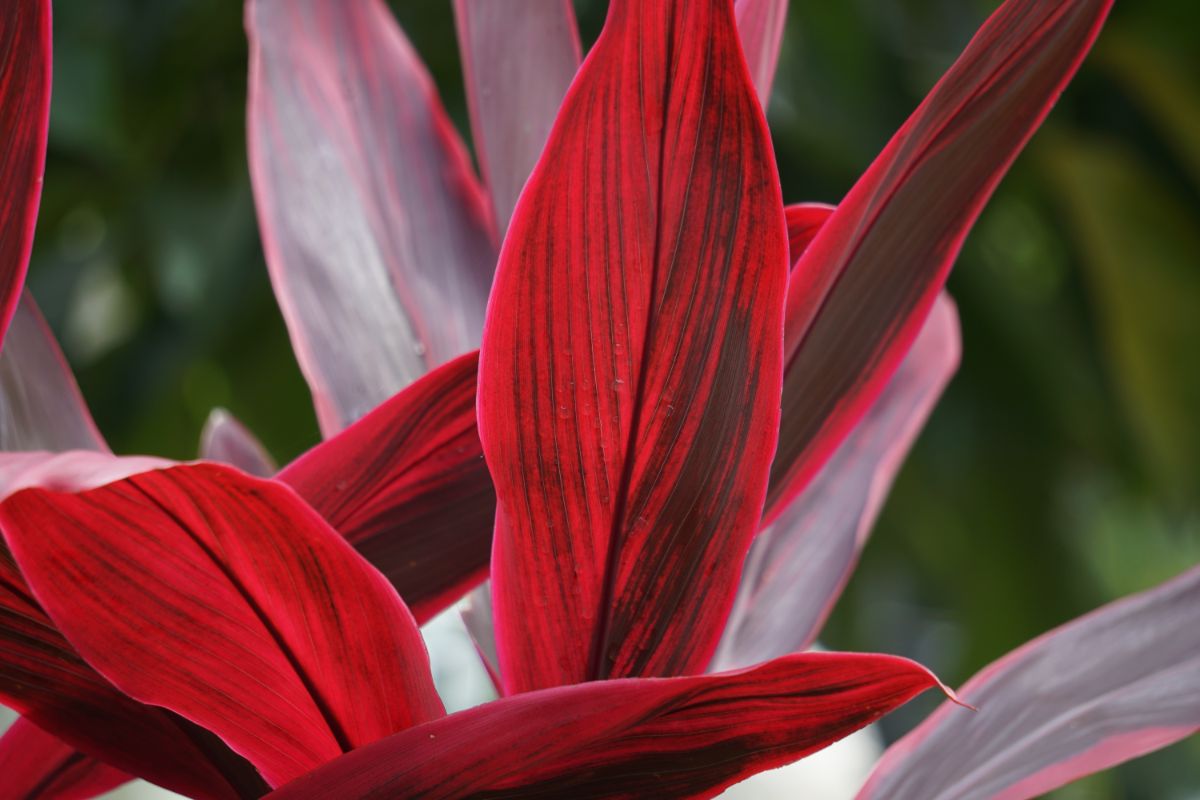
| Plant name: | Ti plant |
| Lighting requirements: | Bright light |
| Watering requirements: | Moderate |
| Safe for pets? | No |
Another popular, fast-growing plant, Ti plant, is sometimes grown as an outdoor ornamental in warmer areas, but it makes a fantastic houseplant too. Broad, lance-shaped leaves come in a range of colors, but the striped, variegated forms are truly spectacular. When grown outdoors, Ti plants will often flower and produce berries, but this is less likely when these plants are kept inside.
Native to Asia, Australia, and the Pacific Islands, Ti plants can grow up to 10’ high. These beauties are actually members of the asparagus family, but they aren’t edible. In fact, they are toxic if ingested, so be sure to keep them out of the way of house pets and small children.
10. Haworthia (Haworthia spp.)
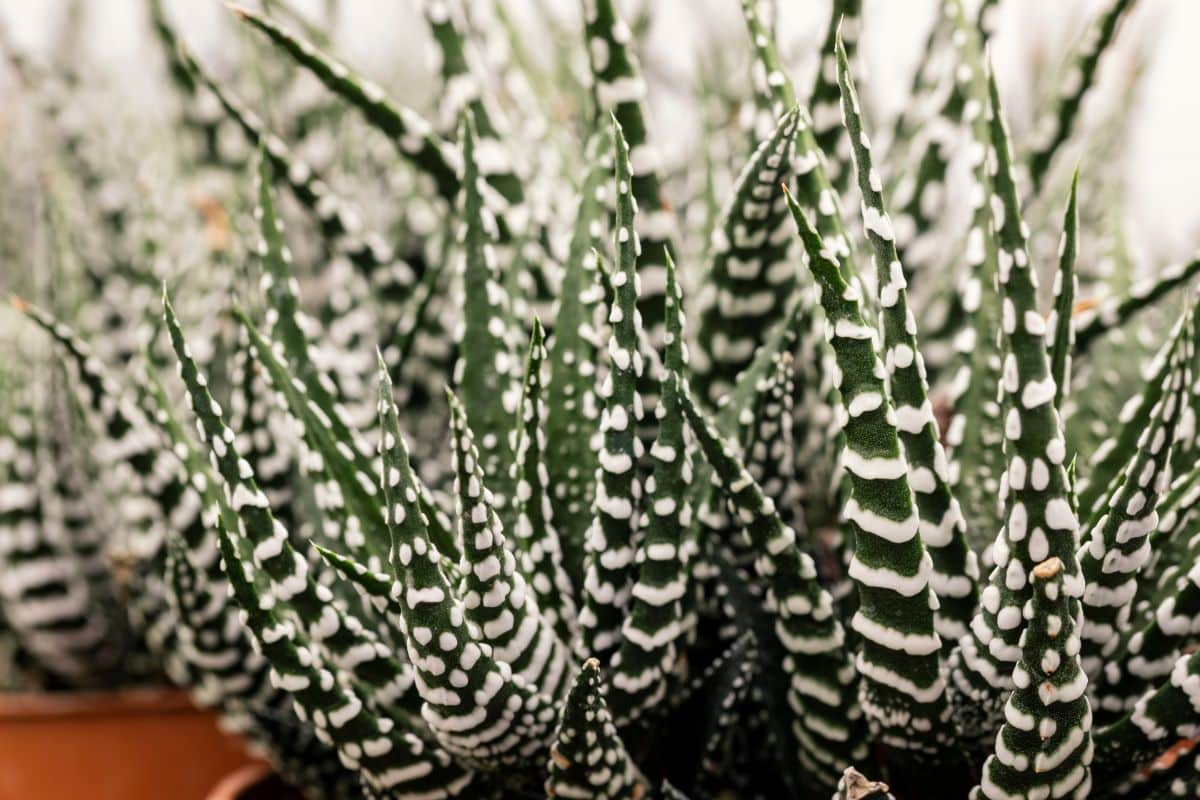
| Plant name: | Haworthia |
| Lighting requirements: | Bright, indirect light |
| Watering requirements: | Low |
| Safe for pets? | Yes |
Haworthia may look a bit like aloes with their spiky, vertical leaves, but these succulents are pet-safe and can tolerate lower-light homes. While there are different types of haworthia, the zebra haworthia is one of the most popular and is prized for its dark green leaves that are striped with white.
As a succulent, haworthia doesn’t need a lot of water and should be watered only once every few weeks or less. To keep your plant looking its best, try potting up your haworthia in a well-draining pot with a potting mix suitable for cacti or succulents. When properly maintained, these slow-growing plants can live 50 years or longer.
11. Prayer plant (Maranta leuconeura)

| Plant name: | Prayer plant |
| Lighting requirements: | Bright, indirect light |
| Watering requirements: | Moderate |
| Safe for pets? | Yes |
If you’re looking for striped and patterned leaves, prayer plants have it all. Their distinct and colorful foliage has stripes of pink and other contrasting tones of green and white. Even better, those leaves move to follow the light and turn upwards in the evening to help the plant conserve its moisture levels.
Like other tropical plants, prayer plants do appreciate a bit of extra humidity, but they don’t necessarily always need a humidifier nearby. If you’re lucky, your prayer plant may also flower small, purple blooms that are adorable in their delicacy. These plants are also easy to propagate via stem cuttings.
12. Variegated banana (Musa × paradisiaca 'Ae Ae')
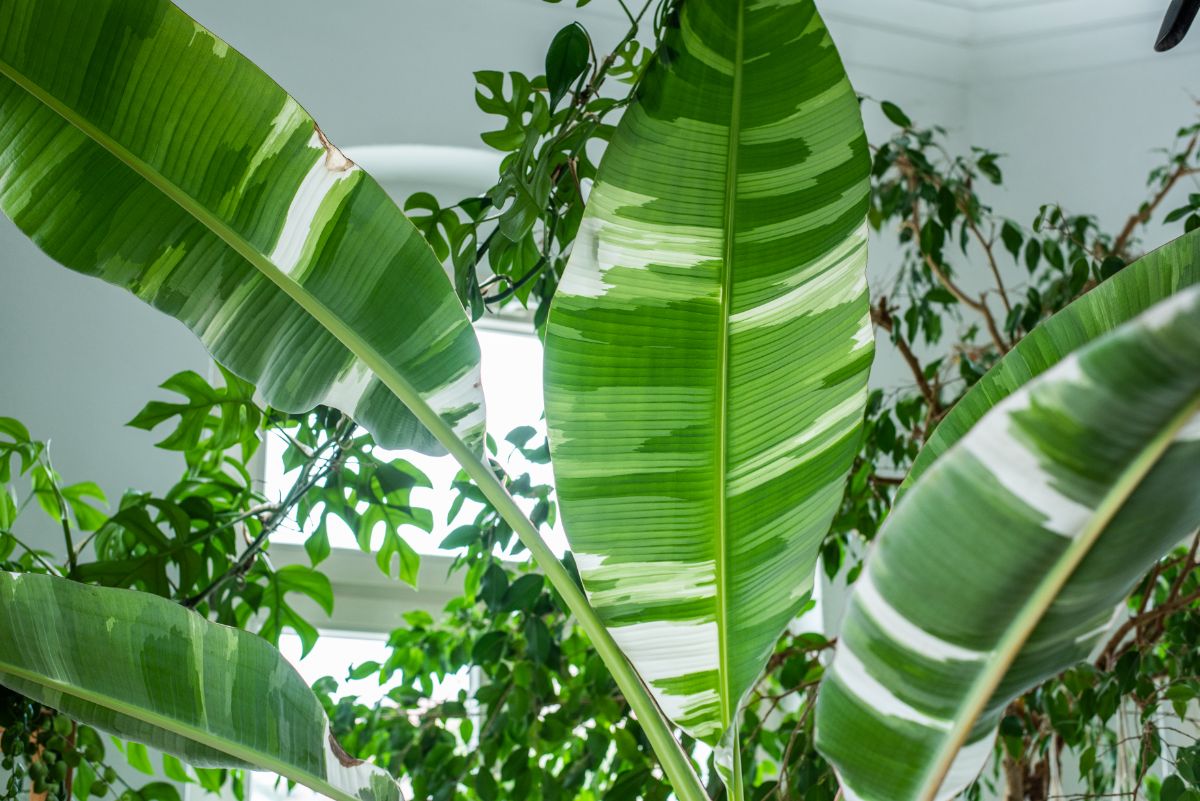
| Plant name: | Variegated banana |
| Lighting requirements: | Bright, indirect light |
| Watering requirements: | High |
| Safe for pets? | Yes |
Did you know you can grow banana trees indoors? You can! While not all banana trees make suitable houseplants, variegated bananas can be kept indoors or outside in warmer climates.
These spectacular plants have intriguing striations on their large, oval leaves. This coloration is quite unique and slightly resembles camouflage in shades of green and white. Variegated bananas will also produce edible fruit, which is a nice added bonus!
Just keep in mind that banana trees can be higher maintenance plants than many other houseplants. So if you want to keep this beauty, be prepared. Banana trees require constantly moist soil and may need to be watered once a day or more.
13. Zebra plant (Aphelandra squarrosa)
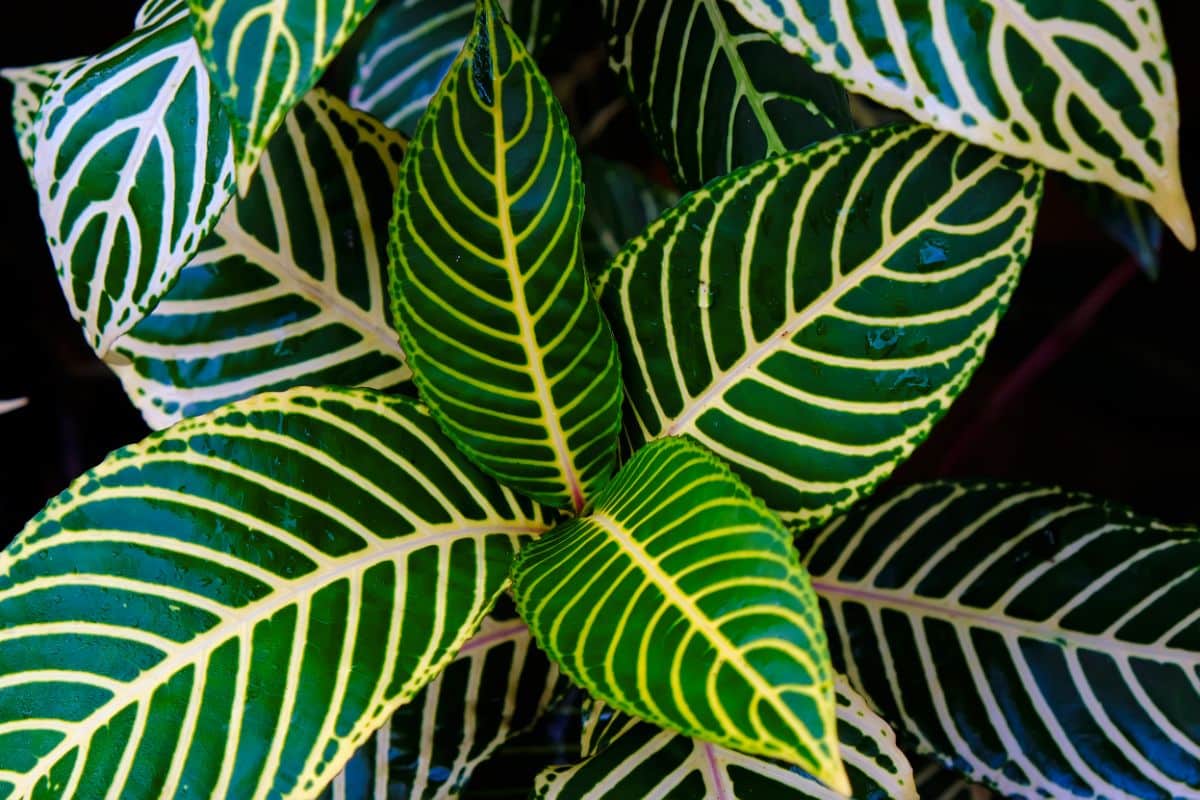
| Plant name: | Zebra plant |
| Lighting requirements: | Bright, indirect light to low light |
| Watering requirements: | Moderate |
| Safe for pets? | Yes |
Not to be confused with the zebra haworthia, the zebra plant is a tropical houseplant with broad leaves that taper towards the tips. Those dark green leaves are ornamented with highly contrasting white veins, which give the leaves an intriguing, striped appearance. In summer, these plants get even more vibrant when they bloom golden, yellow bracts that can measure several inches long.
Like banana trees, zebra plants can be a bit trickier to keep happy, so they aren’t well suited for new gardeners. These Brazilian natives like consistently moist soil and higher than average humidity levels – 60 to 70%. They should also be kept in bright, indirect light only, as bright light can cause leaf damage.
14. Croton (Codiaeum variegatum)
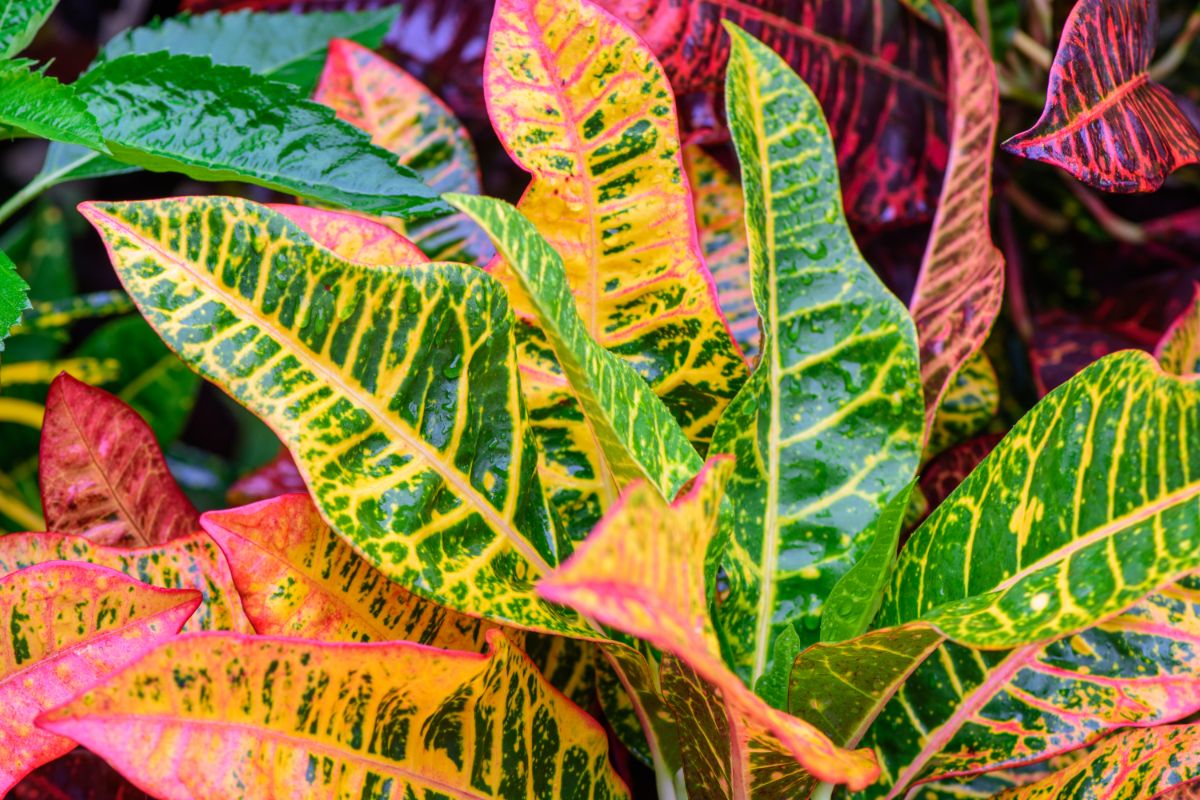
| Plant name: | Croton |
| Lighting requirements: | Bright light |
| Watering requirements: | Moderate |
| Safe for pets? | No |
Crotons are often kept as outdoor plants and potted up in autumn container gardens, but these festive plants make perfect plants for indoors too. There are many different croton types with highly colorful leaves. Some leaves are spotted, some have splashes of color, and some are striped with leaf veins in contrasting hues.
Indoors, crotons are relatively easy to manage plants and just require bright light and consistent watering. However, these plants can be prone to mealybugs, so if you’re moving an outdoor plant inside, be sure to check it carefully for any unwanted pests. To be safe, you can also spray your plant preventatively with an organic insecticidal soap spray before bringing it indoors.
15. Birkin philodendron (Philodendron Birkin)
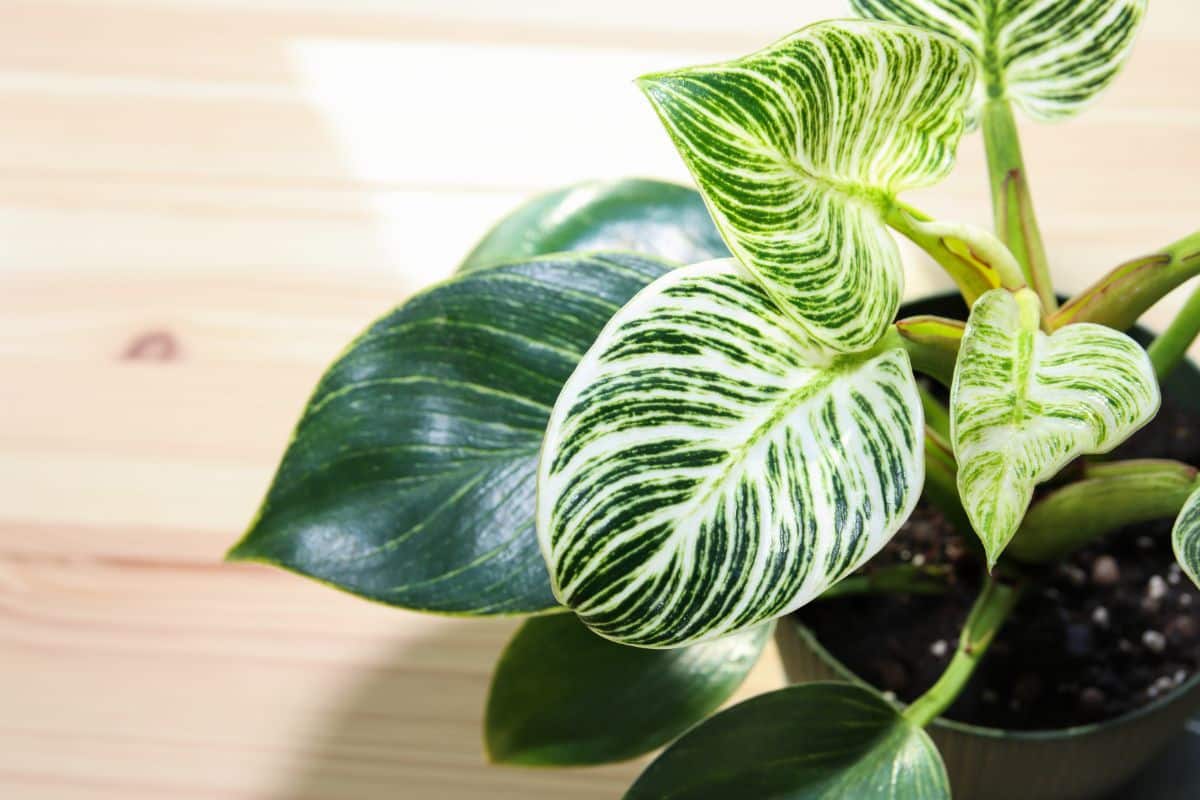
| Plant name: | Philodendron Birkin |
| Lighting requirements: | Bright, indirect light |
| Watering requirements: | Moderate |
| Safe for pets? | No |
Philodendrons are a very varied genus of plants and include some popular favorites like the velvet leaf philodendron and the heart leaf philodendron. But if you’re a fan of striped plant leaves, the Birkin philodendron is the cultivar to find.
This chic-looking foliage plant has rounded leaves that taper towards the tips. But what makes these plants really stand out is the bright white, pinstripe patterning on their deep green leaves. Placing your plant in plenty of bright, indirect light can help bring out the variegation patterning and improve leaf contrast.
16. Variegated cast iron plant (Aspidistra elatior 'Variegata')

| Plant name: | Variegated cast iron plant |
| Lighting requirements: | Bright, indirect light |
| Watering requirements: | Moderate |
| Safe for pets? | Yes |
Cast iron plants are popular among plant keepers thanks to their very low maintenance grow requirements. In fact, these plants are so easygoing that their name “cast iron plant” actually comes from how indestructible they are. But if you love the standard green cast iron plants, the variegated version is definitely a must-have too!
Cast iron plants can generally handle low-light rooms, but variegated cultivars need bright, indirect light to help preserve their variegation. In lower-light rooms, plant leaves may revert to solid green and lose their striping.
Beyond their beauty, cast iron plants are one of the best plants to keep to improve indoor air quality. They are also pet friendly.
17. African mask (Alocasia x amazonica 'Polly’)

| Plant name: | African mask |
| Lighting requirements: | Bright, indirect light |
| Watering requirements: | Moderate |
| Safe for pets? | No |
The African mask is a very elegant plant in the elephant ear family, but you won’t find this one in nature. This cultivar was developed in the 1950s in a Florida greenhouse and was specially selected for its neat and compact size and highly ornamented, striped leaves.
African mask leaves are very distinct, with a deep green, glossy base, and bright white veins. When mature, the plant maxes out at around 24” high. Although African mask plants only live for about 5 years, they can be easily propagated by dividing your plant.
18. Round leaf calathea (Calathea orbifolia)
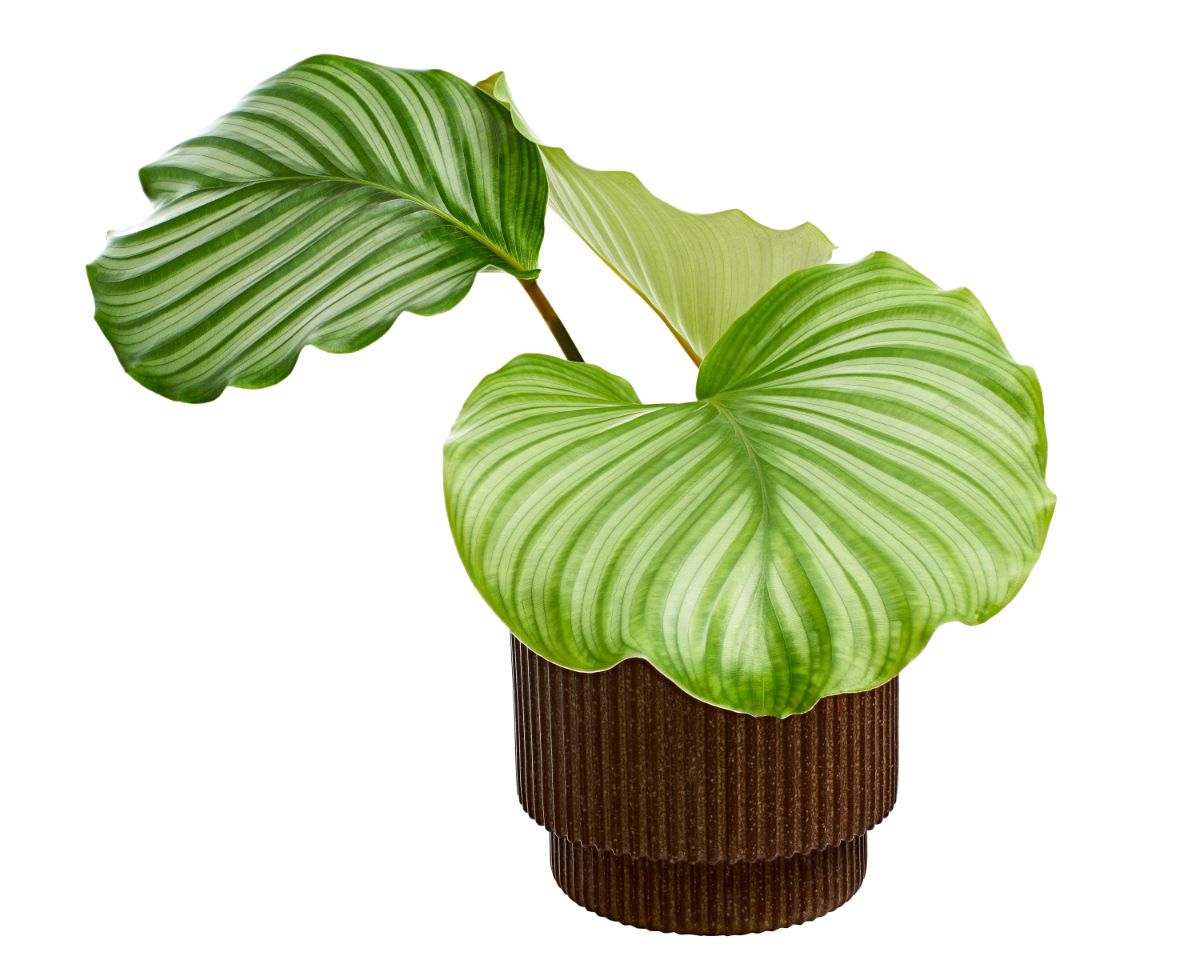
| Plant name: | Round leaf calathea |
| Lighting requirements: | Bright, indirect light |
| Watering requirements: | Moderate |
| Safe for pets? | Yes |
In its native Bolivia, the round leaf calathea grows in humid rainforests and will grow best indoors if you try to replicate its natural habitat. That means providing your plant with plenty of moisture, high humidity, and bright, dappled light. Adding a pebble tray or humidifier to your plant’s setup can increase ambient humidity levels and keep your plant’s leaves crisp and vivid.
Growing about 2 to 3’ in height, the round leaf calathea is mostly collected for its striped leaves. That’s because, while it does flower, blooming is rare indoors. With proper care, this delightful little plant can make a wonderful houseplant, and it is also safe for pets.
19. Pinstripe calathea (Calathea ornata)
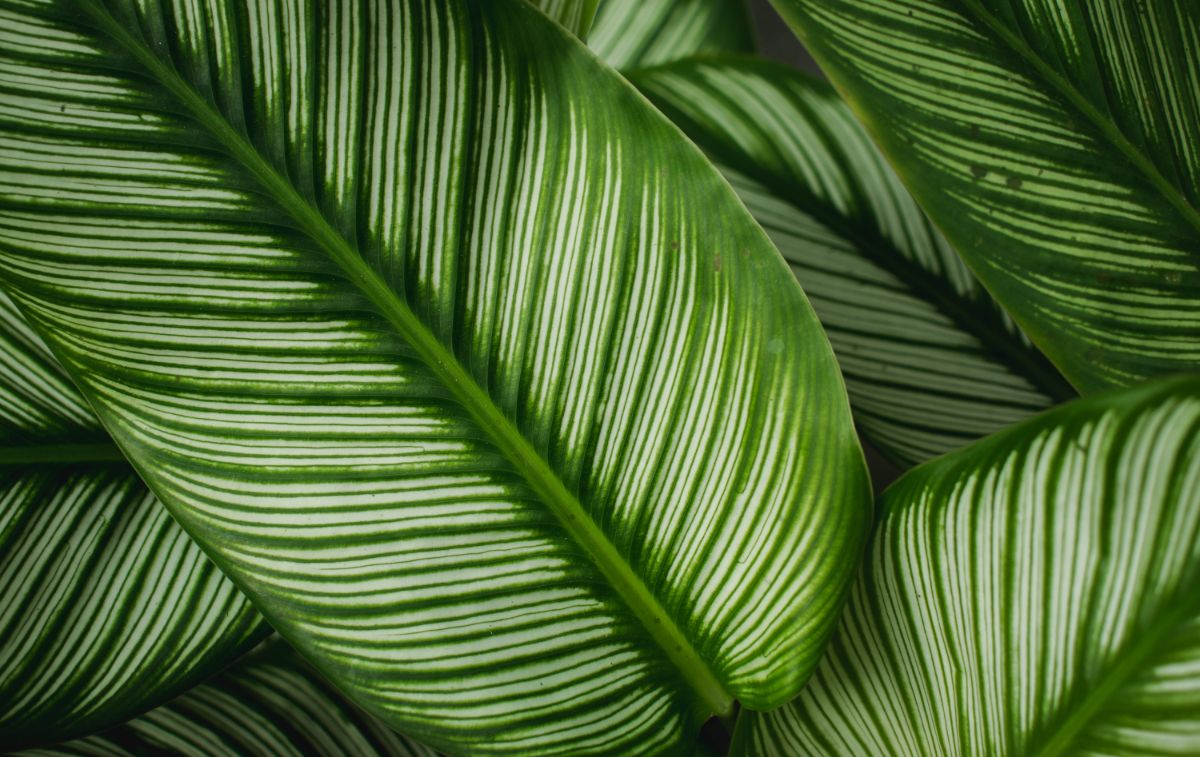
| Plant name: | Pinstripe calathea |
| Lighting requirements: | Bright, indirect light |
| Watering requirements: | Moderate |
| Safe for pets? | Yes |
Another gorgeous calathea option is the pinstripe calathea which has a slender lining across its rounded and tapering leaves. This pretty plant is closely related to the prayer plant, but it has slightly more demanding needs. Specifically, it prefers humidity levels between 40 and 60%, so it is best kept near a humidifier or in a steamy and well-lit bathroom.
Too much bright sun can cause leaf burn on your calathea, so locate your plant in a bright, indirectly lit window or shelter it from the full sun behind a sheer curtain. This plant also prefers well-draining, peat-based soil. If your plant’s leaves start to curl, be sure to double-check your moisture and humidity levels.
20. Nerve plant (Fittonia albivenis)
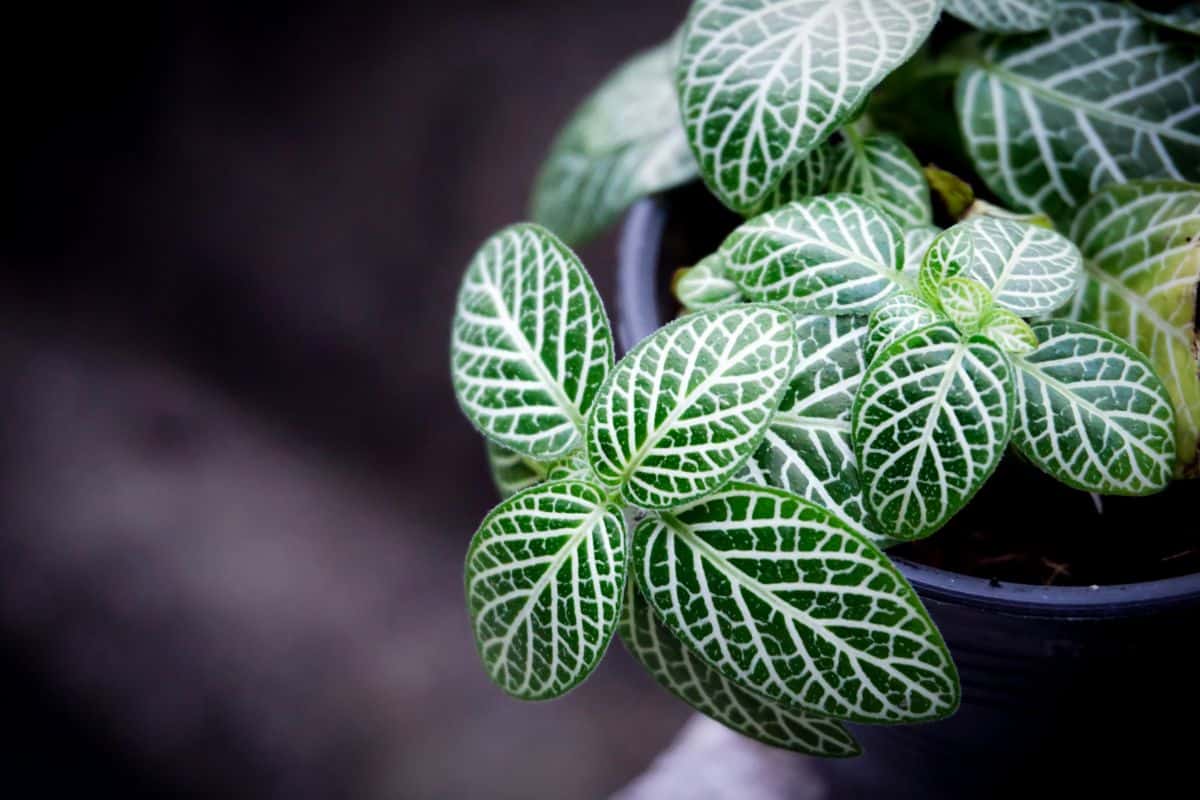
| Plant name: | Nerve plant |
| Lighting requirements: | Medium to low light |
| Watering requirements: | High |
| Safe for pets? | Yes |
Nerve plants are popular houseplants that are known for their vividly striped leaves. Leaves are small and delicate and feature colorful stripes of veins that come in green, white, pink, silver, and red. Nerve plants are also small houseplants and rarely grow taller than 6” high.
These plants are known to be a bit difficult to keep, but there is a secret to growing them successfully: high humidity. Nerve plants don’t like to dry out, and they need humidity levels of 50% or higher. The good news is that because these plants are so small, they can easily fit inside terrariums for better humidity control.
Frequently asked questions
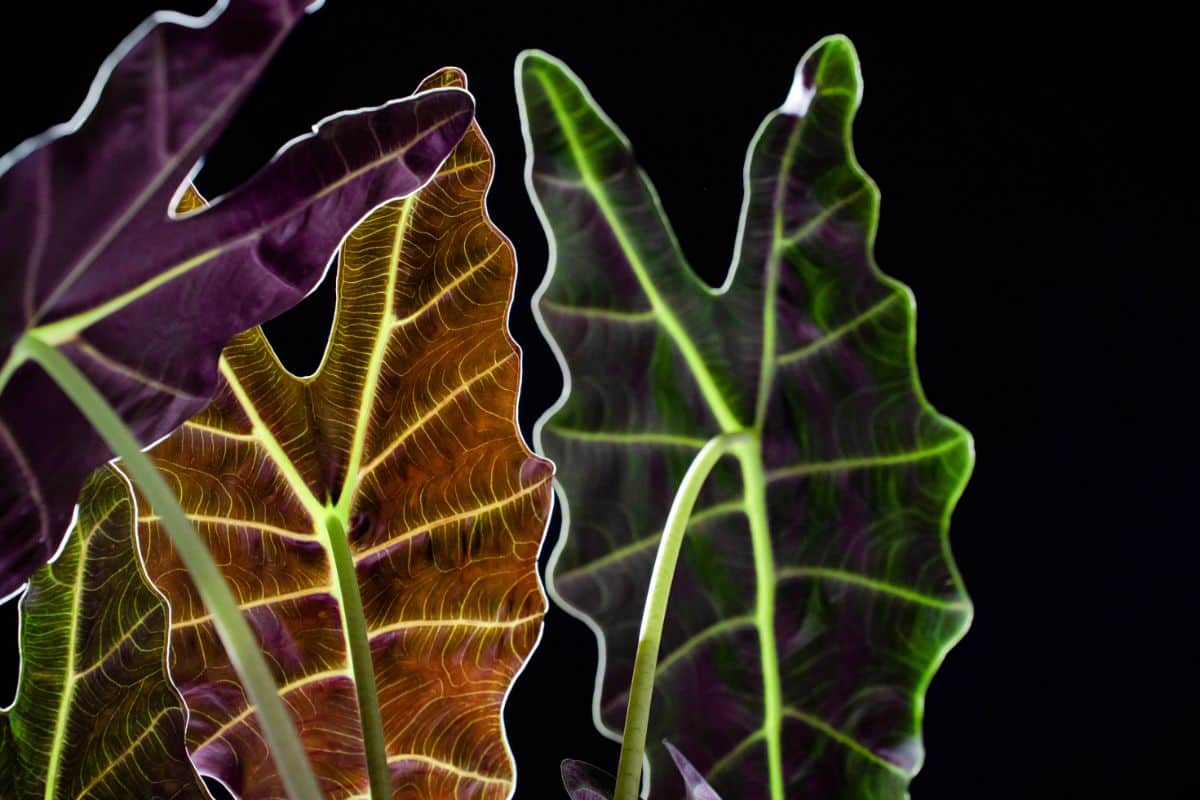
Many popular houseplants have striped and variegated leaves that will create a stunning display when added to your collection. Some popular choices include snake plants, spider plants, and zebra plants.
Variegated, striped plant leaves can be caused either by a plant’s genetics or a random mutation. Plant scientists and nursery workers can selectively cultivate plants for greater variegation and striped patterning. Random mutations that cause variegated leaves also occur, but they are much more rare.
Zebra plants prefer higher-than-average humidity levels. So if your zebra plant is suffering from brown or crispy leaves, try adding a humidifier to your setup. Zebra plants also grow best in consistently moist, but not soggy, soil and bright, indirect light.
Striped stems are less common than striped leaves; however, there are a few gorgeous houseplants that have this unique feature. One top houseplant pick with striped stems is Alocasia zebrina ‘Tiger.’
Summary
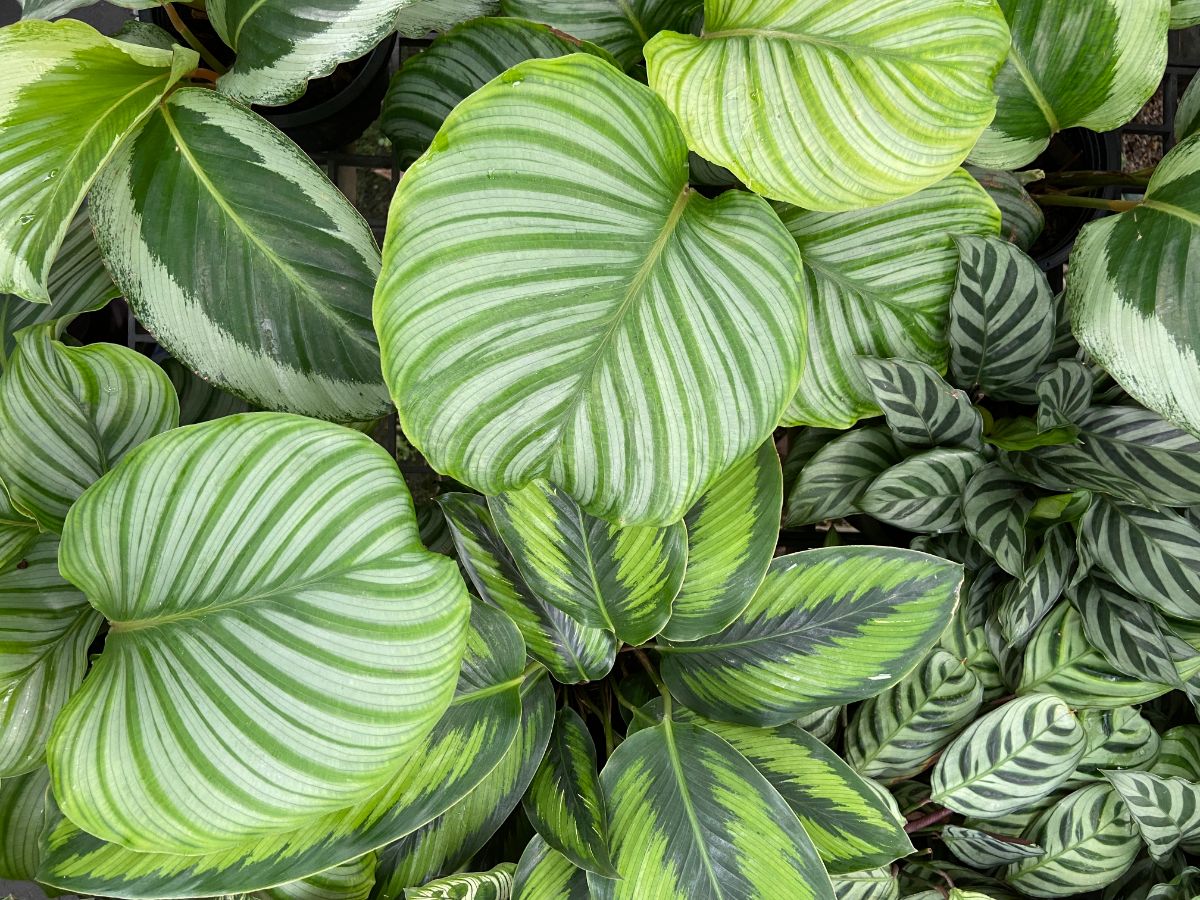
Houseplant keepers who love foliage plants are in for a treat. There are plenty of highly patterned and variegated indoor plants to choose from, and some of the most delightful are plants with striped leaves.
From spider plants to calatheas, there’s a surprising amount of striated houseplants with colorful and contrasting leaves. While these plants look beautiful on their own, adding a few together to an indoor shelf or display rack can increase the impact of each dramatically. So, if you can’t choose your favorite striped plant we’ve covered today, why not grab a few!
We hope you liked this article! For more houseplant inspiration, check out our guide on the best air-purifying plants here.


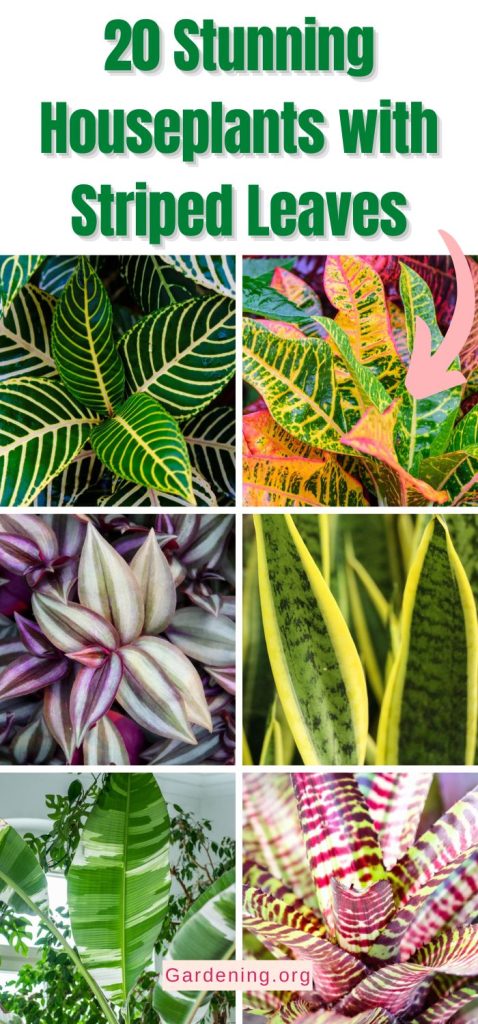
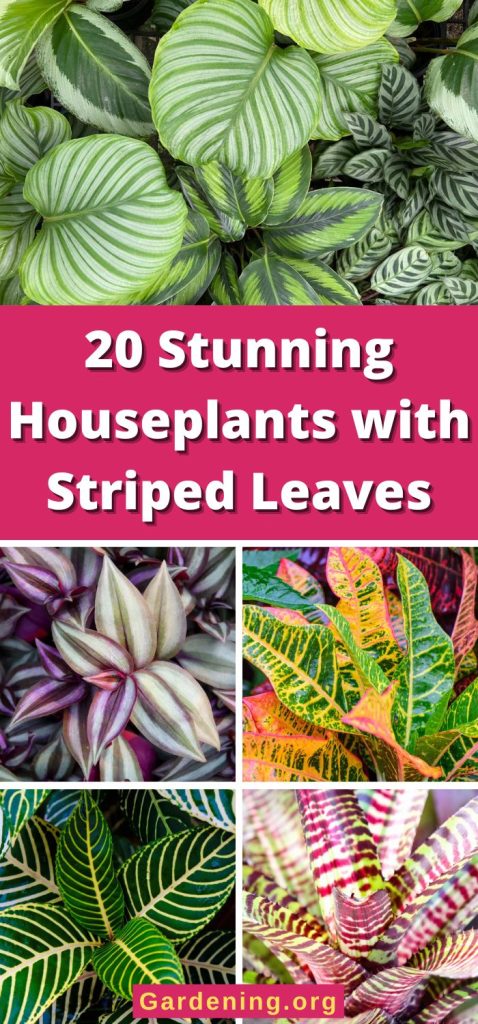
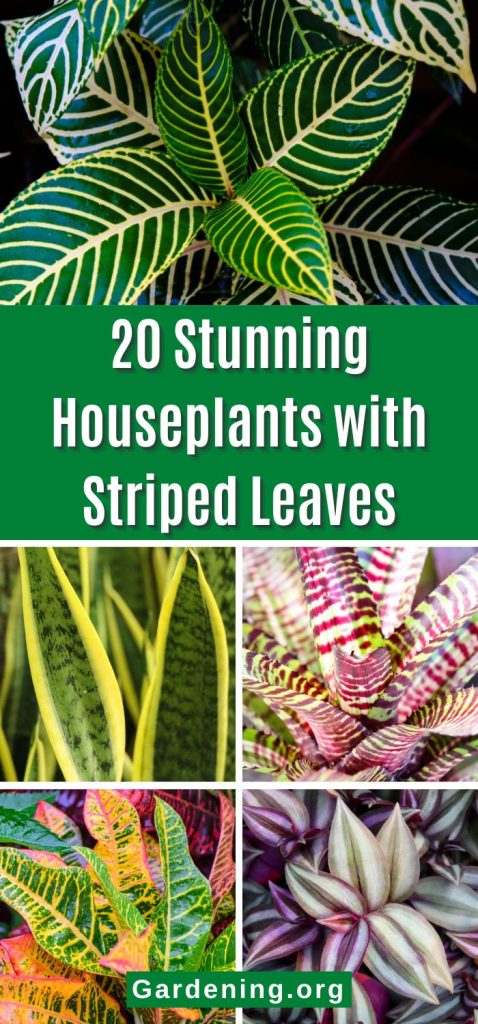
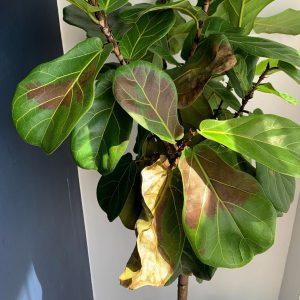
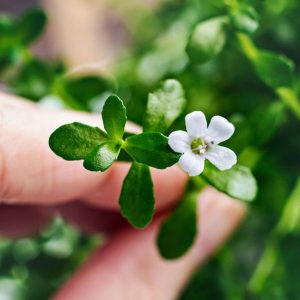
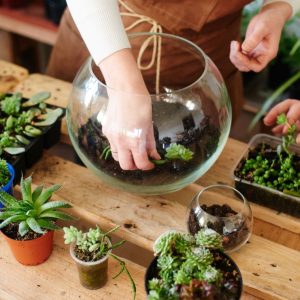

Melt van Zyl
Kan ek bostaande plante aankoop vir n kleinhandels kwekery in Wolmaranstad?
Mary Ward
I'm sure there are at least some you can purchase, but you'd have to check with vendors.